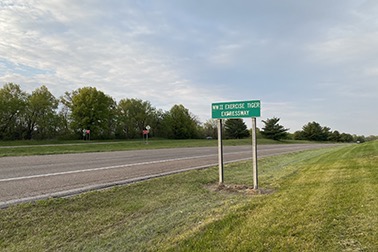EXERCISE TIGER
August 2023

On the road between Kingdom City and Auxvasse thousands of travelers pass a sign designating a stretch of Highway 54 as WWII Exercise Tiger Expressway. Most of them don’t know what Exercise Tiger means.
It’s the story about the ambush that left the fate of hundreds of local soldiers and sailors shrouded in mystery for a half century.
Decades passed before Leonard Bruns learned what really happened. He remembers that cold April night in 1944, when he was a 19-year-old Army corporal, just one soul doing his part to prepare the world for peace. Under cover of darkness, his squad stormed a beach with advance troops and engineers. The beach was Slapton Sands, on English soil.
At the time, he wasn’t aware of the scope of the mission. This event was a rehearsal for D-Day, the pivotal invasion that would turn the tide of war in the Allies’ favor.
“I was in the signal corps,” Leonard recalls, “attached to the engineers. My job was communications, setting up phone lines on the battlefield and signals from ship to shore. When this thing occurred, we were already on the beach.”
“This thing” turned into a bloody German assault. Allied commanders picked Slapton Sands as a practice area because it resembled the D-Day target at Utah Beach. Just off that English coast, in the darkness, a random patrol of nine German naval torpedo boats discovered eight U.S. LSTs (landing ship tanks) carrying soldiers to the landing area. The hour-long attack left 749 Allied troops dead, including soldiers and sailors from Missouri, especially Boone, Callaway and Audrain Counties.
In his book, “The Forgotten Dead”, Ken Small suggests that Exercise Tiger “was never covered up; it was ‘conveniently forgotten.’”
David Troyer knew about it. He was an Army private first class among “the first army units to take amphibious training. In Southampton, we boarded ship and headed for Slapton Sands, but we didn’t know why at the time. We were onboard a landing craft away from the LSTs that were attacked.”
Troyer has spent much of his life piecing together the details of that night. “Everything went wrong that could possibly go wrong,” he says. There was only one gunboat escort as one other escort had collided with another ship and had left for repairs. LST531 was hit by two torpedoes, sank in six minutes. The British and American navies were on two different radio frequencies, so when the LSTs called for help, nobody came. LST515 went back to pick up survivors, against orders. The captain was court martialed and demoted.”
In the confusion, soldiers were taken out by friendly fire during the live fire exercise.
“Next morning, they moved us off the beach right quick. We were sworn to secrecy,” he says. “We bivouacked five weeks in an isolated area. The night before D-Day they served us steak with cherry pie and ice cream at midnight. Then, because of weather, the landing was postponed for 24 hours. So our ‘last meal’ ended up being K-rations.”
Now when you pass that Exercise Tiger Memorial Highway sign, you’ll know the whole story.
